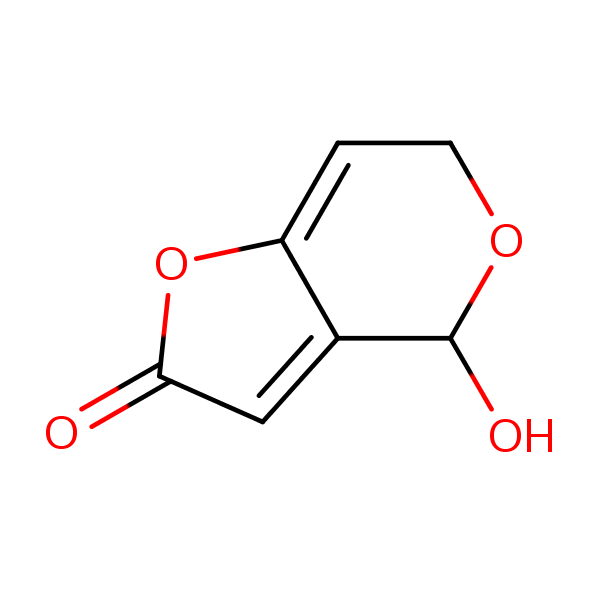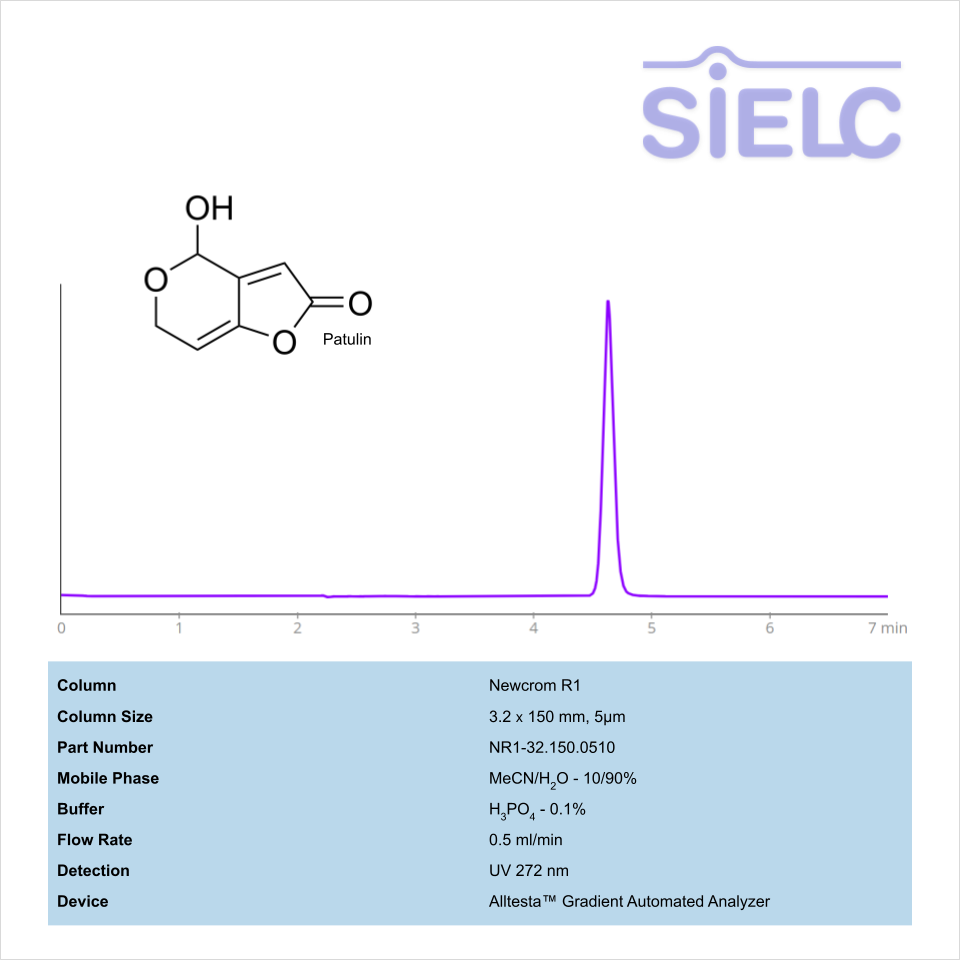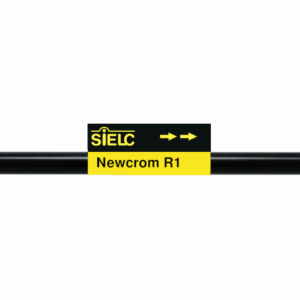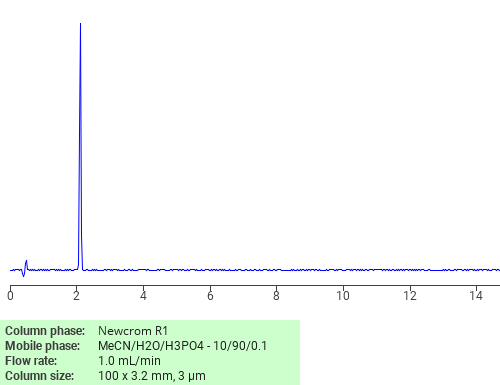| CAS Number | 149-29-1 |
|---|---|
| Molecular Formula | C7H6O4 |
| Molecular Weight | 154.121 |
| InChI Key | ZRWPUFFVAOMMNM-UHFFFAOYSA-N |
| LogP | -0.755 |
| Synonyms |
|
Applications:
HPLC Method for Analysis of Patulin on Newcrom R1 Column on Alltesta™
September 23, 2025
HPLC Method for Patulin on Newcrom R1 by SIELC Technologies
High Performance Liquid Chromatography (HPLC) Method for Analysis of Patulin
Patulin is a fungi produced mycotoxin with the molecular formula C7H6O4. It is lethal to rodents, as well as causing a myriad of health problems to other animals, including rats, mice, chickens, and hamsters. It is typically found on fruits and vegetables, especially apples. Extended exposure to patulin may potentially lead to tumor formation.
Patulin can be retained and analyzed using the Newcrom R1 stationary phase column. The analysis utilizes an isocratic method with a simple mobile phase consisting of water and acetonitrile (MeCN) with a ammonium formate buffer. Detection is performed using UV.
| Column | Newcrom R1, 3.2 x 150 mm, 5 µm, 100 A, dual ended |
| Mobile Phase | MeCN – 10% |
| Buffer | Phosphoric Acid |
| Flow Rate | 0.5 ml/min |
| Detection | UV 275 nm |
| Class of Compounds | Mycotoxin |
| Analyzing Compounds | Patulin |
Application Column
Newcrom R1
Column Diameter: 3.2 mm
Column Length: 150 mm
Particle Size: 5 µm
Pore Size: 100 A
Column options: dual ended

HPLC Method For Analysis Of Patulin on Newcrom R1 Column
August 19, 2021
HPLC Method for Patulin on Newcrom R1 by SIELC Technologies
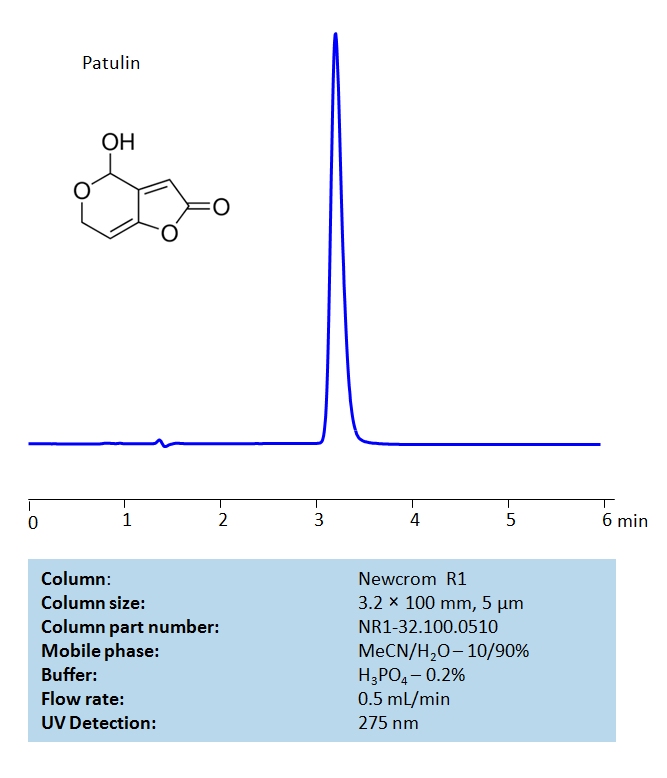
High Performance Liquid Chromatography (HPLC) Method for Analysis of Patulin.
Patulin is a toxic chemical contaminant produced by several species of mold, especially within Byssochlamys Aspergillus and Penicillium. It is the most common mycotoxin found in apples and apple-derived products such as juice, cider, compotes and other food intended for young children.
Patulin can be retained in HPLC on Newcrom R1 reverse-phase column with the simple isocratic mobile phase consisting of acetonitrile (MeCN, ACN), water and Phosphoric Acid (H3PO4) buffer. The analysis method can be UV detected at 275 nm.
| Column | Newcrom R1, 3.2 x 100 mm, 5 µm, 100 A, dual ended |
| Mobile Phase | MeCN – 10% |
| Buffer | H3PO4 – 0.2% |
| Flow Rate | 0.5 ml/min |
| UV Detection | 275 nm |
| LOD | 0.002 ppm |
| Class of Compounds | Hydrophilic |
| Analyzing Compounds | Patulin |
Application Column
Newcrom R1
Column Diameter: 3.2 mm
Column Length: 100 mm
Particle Size: 5 µm
Pore Size: 100 A
Column options: dual ended

Separation of Patulin on Newcrom R1 HPLC column
February 16, 2018
Patulin can be analyzed by this reverse phase (RP) HPLC method with simple conditions. The mobile phase contains an acetonitrile (MeCN), water, and phosphoric acid. For Mass-Spec (MS) compatible applications the phosphoric acid needs to be replaced with formic acid. Smaller 3 µm particles columns available for fast UPLC applications. This liquid chromatography method is scalable and can be used for isolation impurities in preparative separation. It also suitable for pharmacokinetics.
Application Column
Newcrom R1
The Newcrom columns are a family of reverse-phase-based columns. Newcrom A, AH, B, and BH are all mixed-mode columns with either positive or negative ion-pairing groups attached to either short (25 Å) or long (100 Å) ligand chains. Newcrom R1 is a special reverse-phase column with low silanol activity.
Select options